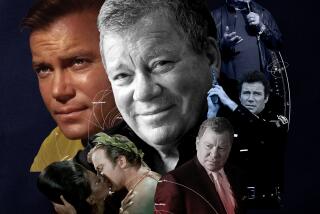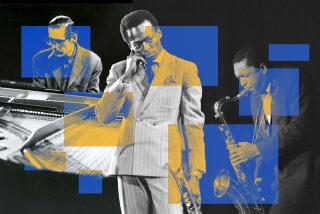Catching Coltrane Live in His Quest
John Coltrane has been gone from this planet for nearly as long a time as he spent here--40 years of life, 35 years departed. Amid the much-deserved celebration that has taken place in this 75th anniversary year of his birth, one persistent thought plays as a subtext to all the earnest rhetoric: Coltrane--like Charlie Parker, George Gershwin, Jimi Hendrix and, for that matter, Wolfgang Amadeus Mozart--had only a brief span of time to accomplish his tasks. Put in the context of his working span as a mature artist, it amounts to not much more than a decade and a half.
Although his early years produced some highly effective, bebop-based playing, the most uniquely creative period of Coltrane’s career encompasses progressively ambitious adventures. First came his effort to stretch the harmonic possibilities of improvisation to their ultimate limits; next, his embrace of the open world of modal improvising; finally, his meditative pursuit of the ultimate “one”--of the very center of music as a spontaneous, spiritual act.
Virtually throughout that entire process, Coltrane was a driven man. Stories abound of instances in which he would play lengthy, two-hour sets in a club, only to retreat to the dressing room during intermission and continue to practice. While no one could deny the magnificence of most of his studio recordings, it was in those live performances that a listener could experience the closest connection with the sheer passion that energized Coltrane’s tenacious quest.
An extraordinary opportunity to encounter that quest in its fullest is present in a superb new seven-CD collection, “John Coltrane: Live Trane, The European Tours” (* * * * Pablo Records). Recorded from 1961 to ’63 in Europe, the concerts featured Coltrane with his regulars of the period--pianist McCoy Tyner, drummer Elvin Jones, bassist Reggie Workman (or, on some programs, Jimmy Garrison), with horn player Eric Dolphy present for dates in 1961.
Because he was employing a relatively modest selection of pieces, the performances afford an extraordinary opportunity to hear the glory of Coltrane in action, at a time in his career when technical prowess allowed his imagination to soar. Six versions of “My Favorite Things” reveal what the song meant to Coltrane, and the manner in which it triggered the elemental viscera of his music. “Impressions” and “Mr. P.C.” are each performed five times, and “Naima” appears in four versions. Performances are lengthy (most of the “My Favorite Things” efforts are 20 minutes or longer, and a 1963 rendering of “Impressions” is over 27 minutes), and soloing is extended.
(Coltrane’s use of the soprano saxophone on “My Favorite Things”--and others--came at a time when it was still rarely heard in jazz, most commonly in the first-rate playing of Steve Lacy. But one suspects that Coltrane turned to the instrument as a reflection of his growing interest in Indian music and, thereby, his fascination with the sound of the shenai --a double-reed instrument with a tonal quality similar to that of the soprano saxophone.)
Will multiple versions of tunes from the Coltrane lexicon primarily appeal to only his most dedicated fans?
I hope not. Although there are passages that will be of the greatest interest to young saxophonists trying to grasp the full extent of Coltrane’s virtuosity, the overwhelming majority of this boxed set is compelling on its own terms. Most important, it preserves the creative process of one of the 20th century’s great artists when he was at the peak of his powers.
Some of these performances have been released in earlier versions. A substantial number of tracks, however, had been unreleased. And the selections, in any case, have never before been available in this quantity and in this correct sequence of performances. For Coltrane fans, in particular, but for those who simply love and honor the art of jazz, this is an invaluable collection.
We can’t overlook yet another live Coltrane recording. In this case--beyond its unquestioned musical value--it is important as the last recording of a final live performance. “The Olatunji Concert: The Last Live Recording” (* * * * Impulse!) took place on April 23, 1967, in Harlem in a center established by Nigerian percussionist Babatunde Olatunji for the teaching of African music, language and culture. Coltrane died of liver cancer less than three months later, on July 17, 1967. (He actually played at a later concert, on May 7 in Baltimore, but if that was recorded, the tapes have not yet surfaced.)
Coltrane’s group for this previously unreleased performance included tenor saxophonist Pharoah Sanders, pianist Alice Coltrane (his wife), bassist Jimmy Garrison, drummer Rashied Ali and percussionist Algie DeWitt (and possibly percussionist Jumma Santos). After a brief introduction by Billy Taylor, only two numbers are presented. The first is Coltrane’s “Ogunde” (actually based on an Afro-Brazilian folk song, “Ogunde Varere”); the second is the ubiquitous “My Favorite Things.”
This is Coltrane at the outer limits of his ultimate quest, supported by players captivated by his urgency, eager to accompany him in a ride to unknown destinations. Sanders is at his very best on “Ogunde,” exploring freely via a tandem saxophone encounter. But it is “My Favorite Things,” now a vastly different number from its earliest Coltrane incarnation, that defines how far Coltrane has come since he first recorded the Rodgers & Hammerstein classic less than a decade earlier. Every Coltrane recorded outing is worth possessing, but this one-of-a-kind chronicle has to rank near the very top of the must-have list.
More to Read
The biggest entertainment stories
Get our big stories about Hollywood, film, television, music, arts, culture and more right in your inbox as soon as they publish.
You may occasionally receive promotional content from the Los Angeles Times.










